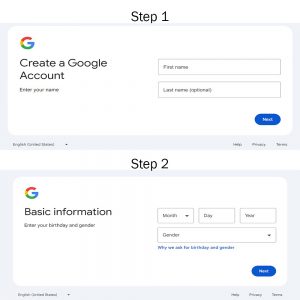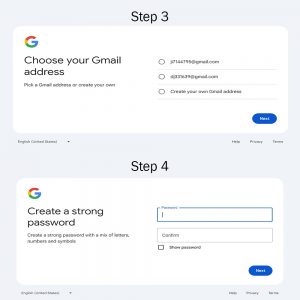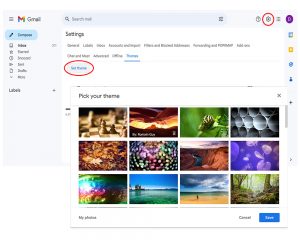Gmail Account Set Up
In today’s digital age, Gmail has emerged as more than just an email service; it’s a gateway to a suite of productivity tools, social interaction, and professional connectivity. With over 1.5 billion active users, Gmail remains one of most popular email platforms worldwide, demonstrating its undoubted relevance in our daily lives. Whether for personal use or professional exchanges, the features and security measures that Gmail offers make it an indispensable tool for communication.
Understanding how to properly set up a Gmail account is crucial, not only to take full advantage of its features but also to ensure that your communications are secure from the get-go. A correctly established account shields you from potential security threats and streamlines your ability to manage communications and integrate with other Google services.
This article is designed to guide you through every step of the Gmail accounts setup process. From choosing the right Gmail settings for privacy and ease of use to customizing your inbox to suit your personal or professional needs, we cover it all. We’ll delve into the best practices for setting up a Gmail account, ensuring you know how to set up Gmail account options like two-factor authentication and recovery methods, which are essential for protecting your account.
Moreover, we’ll explore how to setup Gmail account features that enhance your emailing experience, such as organizing emails, using smart replies, and scheduling messages to boost your productivity. By the end of this guide, you’ll not only have your Gmail setup completed but also customized to your liking and secured against common security threats.
Whether you’re a first-time user or looking to refine your existing account, this article will provide you with all the necessary details to set up a new email account on Gmail effectively. So, let’s get started and unlock all that Gmail has to offer!
Preparing to Create Your Gmail Account
Before you dive into the Gmail accounts setup process, it’s important to gather all the necessary information and make some key decisions. Preparing thoroughly will streamline your Gmail setup and ensure that you can start using your account without any hitches.
-
Essential Information You Need:
First and foremost, setting up a Gmail account requires you to provide some basic personal information. This includes your first and last name, your birthdate, and a recovery email address which can be used to restore your account if you ever forget your password or need to recover access. Additionally, a phone number is highly recommended during the Gmail setup process for security reasons. Google uses this to verify your identity, which helps protect your account from unauthorized access.

-
Choosing Your Gmail Username:
One of the most challenging aspects of setting up a new Gmail account is selecting a suitable username. Since Gmail has billions of users, finding a unique username that hasn’t already been taken can be tricky. Your username will also be email address, so it’s important to choose something that you are comfortable sharing professionally and personally.
Here are a few tips for choosing a Gmail username when you set up a new Gmail email account:
-
Use Variations:
If your preferred username is taken, try adding numbers, underscores, or abbreviations that make the username unique to you.
-
Keep it Professional:
Especially if you plan to use your Gmail for professional purposes, choose a username that represents you appropriately.
-
Consider the Future:
Pick a username that you’ll be happy to have several years from now. Changing a Gmail username later can be cumbersome, as it essentially requires creating a new account.
When you set up new Gmail account, remember that your username is the first impression you make in the digital world, so it’s worth spending some time to get it right.
-
Getting Started:
Now that you understand what’s required for setting up a new Gmail account, and how to tackle the challenge of choosing a username, you are well-prepared to move forward. This preparation ensures that the process of set up a Gmail account will be smooth, allowing you to quickly move on to utilizing your new Gmail to its fullest potential.
In the following sections, we will guide you through the actual steps of creating your account, securing it, and customizing it to fit your needs. Whether you’re wondering how do I set up a new Gmail account or you’re ready to jump right in, follow along as we break down the process into easy-to-follow steps.
Step-by-Step Process to Set up Gmail Account
Creating a new Gmail account is straightforward. This section provides detailed, step-by-step instructions to set up a Gmail account, ensuring you have a smooth setup process. Follow these guidelines closely to effectively set up your Gmail account. 
-
Visit the Official Gmail Website:
To begin the Gmail accounts setup, open your web browser and go to gmail.com. Here you’ll find the option to log in or create a new account. For first-time users looking to set up a new email, click on the “Create an account” option for yourself or to manage your business.
-
Click on “Create an account”:
After clicking “Create an account,” you’ll be directed to the registration form. This is your first step in setting up a Gmail account. Ensure you are on a secure network during this process to protect your personal information.
-
Fill in Your Personal Information:
The form will ask you to enter your personal information, including your first and last name, and the date of birth. This data helps secure and personalize your account experience. Be accurate with the information to avoid issues with account recovery later.
-
Choosing a Username:
This step is crucial as your username will also be email address. As mentioned earlier, finding a unique username can be challenging due to vast number of users. If your desired username is taken, Gmail will suggest available alternatives, or you can try a new combination. This username will be pivotal in how you are identified by recipients and in your professional engagements online, so choose wisely to reflect your identity or brand.
-
Setting a Password:
Create a strong password to protect your account from unauthorized access. Usually, a strong password includes a combination of letters, numbers, and symbols. It’s advisable to use a unique password that you have not used on other sites. Re-enter your password for confirmation to proceed.
-
Including Screenshots to Guide through the Process:
For visual learners, screenshots of each step can be incredibly helpful. Below each instruction, you’ll find images showing exactly what you should be seeing on your screen at each step of the Gmail setup account This will help ensure you’re following along correctly and make the setup process easier to understand.
 By following these comprehensive instructions, you can successfully setup a Gmail account. Whether you are setting up a new Gmail account for personal use or professional purposes, these steps will guide you through creating a secure and functional account that you can start using immediately. Remember, Gmail settings are crucial for managing your new account’s preferences and security features, which we will cover next in our guide.
By following these comprehensive instructions, you can successfully setup a Gmail account. Whether you are setting up a new Gmail account for personal use or professional purposes, these steps will guide you through creating a secure and functional account that you can start using immediately. Remember, Gmail settings are crucial for managing your new account’s preferences and security features, which we will cover next in our guide.
Setting Up Gmail Account Security Features
In today’s digital world, the security of your email account cannot be overstated. A secure email setup not only protects your personal information from unauthorized access but also safeguards your communications and maintains your privacy. This section will guide you through the essential security features of Gmail setup, including Gmail setup 2 step verification, security questions, and the importance of adding a recovery email and phone number.
-
Importance of Securing Your Email Account:
Your email account is a central hub for not only personal and professional communication but also for managing various online accounts. A breach can lead to third party access to all connected services. That’s why enhancing the security of your Gmail setup is a critical step in setting in Gmail account
-
Activating Two-Factor Authentication:
One of the most effective ways to secure your account is through Gmail setup 2 step verification. This adds a additional layer of protection by requiring two different forms of identification before you can log in. The first layer is your password, and the second is typically a code sent to your phone or generated through an authenticator app. This means even if someone gets your Gmail’s password, they won’t be able to access your Gmail account without also having access to your second factor.
To activate two-factor authentication:
-
- Go to the Gmail settings.
- Navigate to the “Security” tab.
- Click on “Two-Step Verification”.
- Follow prompts to set up your verification method.
This setup significantly enhances your account’s security and is a recommended step right after you set up new Gmail accounts.
-
Choosing Security Questions:
While less common now due to the security offered by two-factor authentication, setting up security questions can add an extra recovery option. Choose questions and answers that are challenging for others to guess but easy for you to remember. It’s important to treat security answers like additional passwords—answers should be unique and not used elsewhere.
-
The Relevance of Recovery Email and Phone Number:
Adding a recovery email and phone number to your Gmail account settings is crucial. These help you regain access to your account if you forget your password or get locked out. The recovery email should be an account you already have secure access to, and the phone number should be one you regularly use.
To add recovery options:
-
- Go to your Gmail settings.
- Under the “Security” section, find “Ways we can verify it’s you”.
- Add an phone number and email address for recovery.
Regularly updating these details is part of good account hygiene and ensures you can always recover your account quickly.
By meticulously setting up these security measures, you make your Gmail not just a tool for communication but a fortified service ready to protect your data. Implementing Gmail setup 2 step verification, choosing strong security questions, and ensuring your recovery options are up to date are all vital steps in securing your new account. With these settings in place, you can use your Gmail set up new account with confidence, knowing your information is well-protected.
Customizing Your Gmail Experience
Once you’ve successfully set up your Gmail account, the next step is to tailor it to fit your personal or professional needs. Customizing your Gmail setup can greatly enhance your email experience, making your interactions more efficient and enjoyable. This section will walk you through changing themes and background settings, organizing your inbox with labels and filters, setting up signatures and automated responses, and adjusting notifications and managing multiple accounts. By exploring these Gmail settings, you can create a truly personalized email environment.
-
Changing Themes and Background Gmail Settings
Gmail setup offers a variety of themes and background options that allow to customize the look and feel of your inbox. Whether you prefer a light, dark, or colourful aesthetic, Gmail’s themes can be tailored to match your style or mood.
To change your theme:
-
- To access Gmail settings, click the gear icon in the top right corner.
- Select “Themes.”
- Choose from a wide range of themes or upload your own photo to use as a background.
This customization can make your email experience more visually pleasing and can help in reducing eye strain with appropriate themes.
-
Organizing Your Gmail Inbox with Labels and Filters
Effective inbox management is key to maintaining productivity and efficiency. Gmail inbox setup allows you to use labels and filters to organize your emails automatically. Labels work like folders but are more versatile because you can apply several labels to a single message.
To create labels and filters:
-
- In the Gmail settings, go to the “Labels” and “Filters and Blocked Addresses” tabs.
- Create new labels to categorize your emails.
- Set up filters to automatically apply labels, archive, delete, star, or forward your emails based on specific criteria.
This organization tool is invaluable for keeping your inbox tidy and ensuring that important emails stand out.
-
Setting Up Gmail Signatures and Automated Responses
Gmail signature settings allow you to create a custom signature that is automatically added to the end of your emails. This is useful for adding your contact information, a professional title, or even a personal message.
To set up a signature:
-
- Go to Gmail settings and select “See all settings.”
- Under the “General” tab, scroll down to “Signature.”
- Create and format your signature and save the changes.
Additionally, setting up automated responses or vacation replies can keep your contacts informed when you are not available to respond immediately.
-
Managing Notifications and Multiple Gmail Accounts
Gmail setup also includes options for notification management, allowing you to decide how and when you want to be alerted about new emails. If you manage multiple email accounts, Gmail’s account switching feature is incredibly helpful.
To adjust notifications and manage accounts:
-
- In the Gmail settings, go to the “Notifications” section to configure alerts.
- Add additional accounts through the “Accounts and Import” tab for easy switching between mailboxes without logging in and out.
By configuring these Gmail settings, you can streamline your email management and make your communication process more efficient. Whether it’s through aesthetic customizations, inbox organization, professional touches with signatures, or managing the way you receive notifications, these adjustments will empower you to use Gmail set up to its fullest potential, making your everyday email interactions more tailored and effective.
Advanced Gmail Features and Integrations
Once you have your basic Gmail setup completed, exploring Gmail’s advanced features and integrations can significantly enhance how you communicate and manage your tasks. This section will introduce you to Google Workspace integration, the synergy between Gmail and other Google services like Google Drive and Calendar, and highlight some useful Gmail plugins and add-ons. These features are designed to streamline your workflow and increase productivity, making Gmail accounts setup not just about email, but a comprehensive tool for managing your digital life.
Introduction to Google Workspace Integration
Google Workspace offers suite of productivity tools that seamlessly integrate with Gmail, providing a powerful combination for business and personal use. When you set up a new Gmail account, integrating it with Google Workspace allows you to access shared drives, documents, spreadsheets, and presentations, all from within your Gmail interface.
To make the most of these features:
- Consider upgrading to Google Workspace if you need advanced collaboration tools.
- Ensure your Gmail settings are configured to work smoothly with Workspace applications like Docs, Sheets, and Slides.
This integration is ideal for those who need robust collaboration tools that extend beyond basic email functions.
Using Gmail with Other Google Services
Gmail’s compatibility with other Google services such as Google Drive and Google Calendar enhances its functionality, making it more than just an email platform. With Gmail accounts setup, you can directly attach files from Google Drive, and create or respond to event invitations using Google Calendar. This integration facilitates better time management and easier access to your files directly from your email.
To integrate Google services:
- Use the plus (+) icon within Gmail to create new Google documents.
- When composing an email, click on the Google Drive icon to attach files directly.
- Sync your Google Calendar with Gmail to manage appointments and receive reminders directly through Gmail notifications.
Brief Overview of Useful Gmail Plugins and Add-ons
Enhancing your Gmail setup with plugins and add-ons can tailor your experience to specific needs. Whether it’s for enhancing productivity, managing your emails better, or integrating other tools you use every day, there is likely a Gmail add-on for it.
Some popular Gmail plugins include:
-
Boomerang:
This allows you to schedule emails to send later, set follow-up reminders, and pause incoming emails.
-
Todoist:
Integrates a to-do list directly into your Gmail, making it easier to manage tasks from your inbox.
-
Grammarly:
Helps improve your writing within Gmail by checking grammar, punctuation, and style.
To add these plugins:
- Visit the Gmail Add-ons store accessible via the G Suite Marketplace.
- Select and install the add-ons you find useful to enhance your Gmail setup.
By leveraging these advanced features and integrations, you can transform your standard Gmail account setup into a dynamic and versatile hub for your communication and productivity needs. Whether you are looking to setup up a new Gmail, set up another account, or set as default for handling all your communication and scheduling needs, these tools can help you create a more integrated and efficient workflow.
FAQs
Q1: How do I start setting up a Gmail account?
- A: To begin setting up a Gmail account, visit the official Gmail website and click on “Create an account”. Follow on-screen instructions to enter your personal details and set up your new account.
Q2: What are the initial steps for Gmail accounts setup?
- A: The initial steps include visiting the Gmail website, selecting ‘Create an account’, and filling in your personal information such as your name, birthdate, and choosing a username and password.
Q3: How can I ensure my Gmail setup is secure?
- A: Secure your Gmail setup by enabling Gmail setup 2-step verification under your account security settings. This adds a extra layer of security by requiring a second form of verification.
Q4: Where can I find Gmail settings for setting up filters and labels?
- A: You can find these options under the Gmail settings menu. Click on gear icon in your Gmail, go to ‘See all settings’, and then navigate to the ‘Filters and Blocked Addresses’ and ‘Labels’ tabs.
Q5: Can I set up another Gmail account and link it to my existing one?
- A: Yes, you can set up another Gmail account and link it to your existing one through the ‘Accounts and Import’ tab in your Gmail settings.
Q6: How do I set up a new email with Gmail for professional use?
- A: Start by setting up a Gmail account as outlined in our guide. Choose a professional-sounding username, and consider setting up a signature and automated responses under the ‘General’ tab in Gmail settings.
Q7: How do I configure Gmail POP settings in my account?
- A: To configure Gmail POP settings, navigate to Gmail settings, go to the ‘Forwarding and POP/IMAP’ tab, and adjust your POP settings as desired.
Q8: What procedures are involved in setting up a new Gmail using IMAP?
- A: To use IMAP, ensure IMAP is enabled in your Gmail settings under the ‘Forwarding and POP/IMAP’ tab. Then, set up your email client with the Gmail IMAP server details.
Q9: How can I set Gmail account as default when using multiple accounts?
- A: In your Gmail settings, navigate to the ‘Accounts and Import’ section, find the ‘Send mail as’ option, and choose the Gmail account you want to set as default.
Q10: How to set up an auto response in Gmail?
- A: To set up an auto response in Gmail, go to Gmail settings, select the ‘General’ tab, scroll down to ‘Vacation responder’, and enter your auto-response message along with the start and end dates.
Conclusion
Throughout this guide, we’ve taken a detailed journey through the process of setting up a Gmail account. From the initial steps of preparation, where we covered the essentials needed before creating your account, to the intricacies of choosing a username and setting a secure password, we have laid out a clear path for Gmail accounts setup. We also delved into the crucial aspects of securing your account with two-factor authentication and other security measures, ensuring that your new email is protected from the outset.
Further, we explored the various customization options that Gmail settings offer, allowing you to tailor your inbox with themes, labels, filters, and more to enhance your email experience. We also introduced the powerful integrations available through Google Workspace and other Google services like Drive and Calendar, which extend the functionality of your Gmail beyond traditional email boundaries. Additionally, the useful plugins and add-ons we discussed can increase your productivity and streamline your communications.
Now that you understand the comprehensive Gmail setup process and the vast array of features it offers, I encourage you to take the next step. Set up a new email account if you haven’t already, and begin exploring the multitude of features at your disposal. Whether it’s for personal use, educational purposes, or professional settings, Gmail offers something for everyone. The flexibility and security of Gmail make it a excellent choice for anyone looking to enhance their digital communication tools.
Remember, the journey doesn’t end here. The more you use Gmail, the more you’ll discover its potential. So, don’t hesitate to dive deeper and set up a Gmail account today. Experiment with different Gmail settings and features to find what works best for you and your needs. And as always, keep your account secure, stay organized, and leverage the full capability of Gmail to empower your communication strategies.
To know more about Gmail setup and resolve its related issues, please visit Gmail Support page.

Ashley garcia
What steps should I follow to ensure maximum security when setting up my Gmail account, and what specific security features does Gmail offer?
Support Admin
When you begin your Gmail accounts setup, prioritizing security is crucial. Start by selecting a strong and unique password that combines upper and lower case letters, numbers, and special symbols. Proceed to enable two-factor authentication, which can be found under your Gmail settings, to add an extra layer of protection; this method requires both your password and a secondary form of verification, such as a code sent to your phone. Additionally, it is vital to set up recovery options by adding a backup email address and phone number in your Gmail setup account settings. These steps collectively fortify your set up Gmail account against unauthorized access and potential security threats.